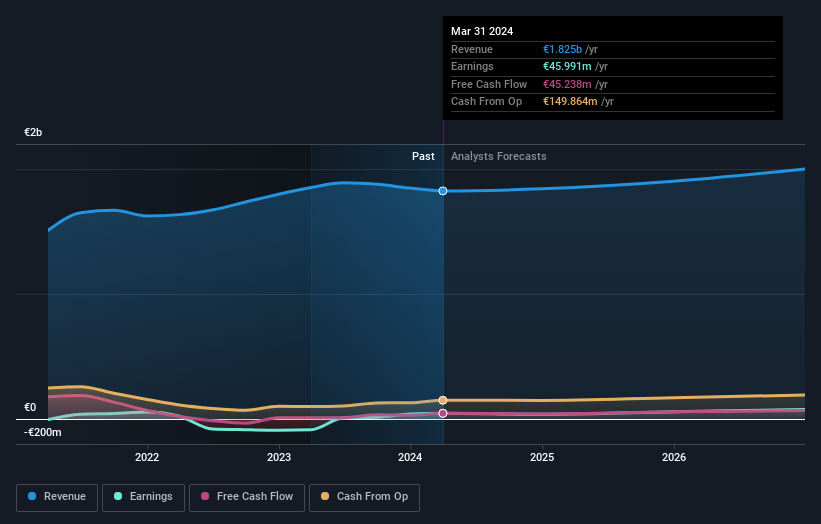- Germany
- /
- Auto Components
- /
- XTRA:ZIL2
ElringKlinger AG's (ETR:ZIL2) 10% loss last week hit both individual investors who own 42% as well as institutions
Key Insights
- ElringKlinger's significant individual investors ownership suggests that the key decisions are influenced by shareholders from the larger public
- The top 3 shareholders own 52% of the company
- Institutional ownership in ElringKlinger is 38%
A look at the shareholders of ElringKlinger AG (ETR:ZIL2) can tell us which group is most powerful. We can see that individual investors own the lion's share in the company with 42% ownership. In other words, the group stands to gain the most (or lose the most) from their investment into the company.
While institutions who own 38% came under pressure after market cap dropped to €275m last week,individual investors took the most losses.
Let's take a closer look to see what the different types of shareholders can tell us about ElringKlinger.
Check out our latest analysis for ElringKlinger

What Does The Institutional Ownership Tell Us About ElringKlinger?
Many institutions measure their performance against an index that approximates the local market. So they usually pay more attention to companies that are included in major indices.
ElringKlinger already has institutions on the share registry. Indeed, they own a respectable stake in the company. This suggests some credibility amongst professional investors. But we can't rely on that fact alone since institutions make bad investments sometimes, just like everyone does. It is not uncommon to see a big share price drop if two large institutional investors try to sell out of a stock at the same time. So it is worth checking the past earnings trajectory of ElringKlinger, (below). Of course, keep in mind that there are other factors to consider, too.

Hedge funds don't have many shares in ElringKlinger. Paul Lechler Stiftung gGmbH, Endowment Arm is currently the company's largest shareholder with 32% of shares outstanding. The second and third largest shareholders are Elgarta GmbH and Lechler Beteiligungs-GmbH, with an equal amount of shares to their name at 10%.
After doing some more digging, we found that the top 3 shareholders collectively control more than half of the company's shares, implying that they have considerable power to influence the company's decisions.
While studying institutional ownership for a company can add value to your research, it is also a good practice to research analyst recommendations to get a deeper understand of a stock's expected performance. Quite a few analysts cover the stock, so you could look into forecast growth quite easily.
Insider Ownership Of ElringKlinger
While the precise definition of an insider can be subjective, almost everyone considers board members to be insiders. The company management answer to the board and the latter should represent the interests of shareholders. Notably, sometimes top-level managers are on the board themselves.
Insider ownership is positive when it signals leadership are thinking like the true owners of the company. However, high insider ownership can also give immense power to a small group within the company. This can be negative in some circumstances.
Our data cannot confirm that board members are holding shares personally. It is unusual not to have at least some personal holdings by board members, so our data might be flawed. A good next step would be to check how much the CEO is paid.
General Public Ownership
The general public-- including retail investors -- own 42% stake in the company, and hence can't easily be ignored. While this size of ownership may not be enough to sway a policy decision in their favour, they can still make a collective impact on company policies.
Private Company Ownership
It seems that Private Companies own 20%, of the ElringKlinger stock. It might be worth looking deeper into this. If related parties, such as insiders, have an interest in one of these private companies, that should be disclosed in the annual report. Private companies may also have a strategic interest in the company.
Next Steps:
It's always worth thinking about the different groups who own shares in a company. But to understand ElringKlinger better, we need to consider many other factors. Take risks for example - ElringKlinger has 1 warning sign we think you should be aware of.
If you are like me, you may want to think about whether this company will grow or shrink. Luckily, you can check this free report showing analyst forecasts for its future.
NB: Figures in this article are calculated using data from the last twelve months, which refer to the 12-month period ending on the last date of the month the financial statement is dated. This may not be consistent with full year annual report figures.
Valuation is complex, but we're here to simplify it.
Discover if ElringKlinger might be undervalued or overvalued with our detailed analysis, featuring fair value estimates, potential risks, dividends, insider trades, and its financial condition.
Access Free AnalysisHave feedback on this article? Concerned about the content? Get in touch with us directly. Alternatively, email editorial-team (at) simplywallst.com.
This article by Simply Wall St is general in nature. We provide commentary based on historical data and analyst forecasts only using an unbiased methodology and our articles are not intended to be financial advice. It does not constitute a recommendation to buy or sell any stock, and does not take account of your objectives, or your financial situation. We aim to bring you long-term focused analysis driven by fundamental data. Note that our analysis may not factor in the latest price-sensitive company announcements or qualitative material. Simply Wall St has no position in any stocks mentioned.
Have feedback on this article? Concerned about the content? Get in touch with us directly. Alternatively, email editorial-team@simplywallst.com
About XTRA:ZIL2
ElringKlinger
Develops, manufactures, and sells components, modules, and systems for the automotive industry in Germany, rest of Europe, North America, the Asia-Pacific, and internationally.
Undervalued with moderate growth potential.
Similar Companies
Market Insights
Community Narratives



